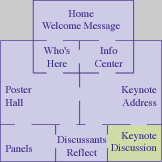Posted by:
Judith Warren Little
Posted on: May 02, 2002 at 2:32 PM
Message:
Sorry for the length of this, but Joni urged discussants to introduce questions & comments, so here goes:So far, Ive read the keynote, the accompanying resource paper, and all of the poster presentations. Id like to ask Michael what he might consider revising or elaborating on the basis of the posters and some other recent work related to the issues he introduces. Here are some of my candidates, in no particular order. [I have some thoughts on each of these, but for the moment, Im introducing them as questions in the hopes that others will take them up]. 1. What difference does school level make? As portrayed in the keynote, the model for managing change seems to treat elementary, middle, and high schools as equivalent contexts for teaching and change. Yet its a common refrain that high schools change least and slowest. Whats gained and whats lost by treating levels of schooling uniformly in this model? 2. What new insights about "system" and "systemic relationships" emerge when you see them through the lens of a particular subject (in this conference, science and mathematics)? The keynote and the resource paper portray a formal system built around institutional levels (state, district, school, classroom). They call to mind a kind of hierarchical organizational chart. The posters make me envision rather different kinds of system maps! 3. Is systemic change good for teachers, teaching and learning? Given that this is a conference on systemic change, this feels a little like one of those "Emperors New Clothes" questions. NonethelessIn the keynote, Michael seems to convey a high degree of faith in systemic change orchestrated closely among state, district and school. But he also says, "We noticed that as literacy and mathematics scores increased that the morale of teachers and principals if anything, was declining." The resource paper that accompanies the keynote adds, "In countries where accountability measures have undermined teachers autonomy, there is now a recruitment crisis ." Several of the posters allude to teachers (and projects) caught in the throes of a changing political and policy climate, and teachers being disheartened when their work gets "dismantled." Sowhat do participants in systemic change make of its potential "dark side?" [A subtext here is clearly the specific vision or conception of learning and teaching conveyed by any particular reform agendaare people prepared to take that up?] 4 Faith in the district? In a similar vein, Im intrigued by Michaels expressed faith in districts as resources for change, which I know has roots in a long history of consortium work in Toronto and in other sites. Yet the posters express a more tempered view, and our own three-year study of Californias restructuring schools show districts to have been obstacles more often than resources for change. The San Diego story, certainly, is more complicated than it appears here. Might it help us to complicate this story more in the hopes of understanding when and how districts can promote improvement? 5. The change model. The discussion of the "change process," including notions of an "implementation dip," seems to imply that there are discrete ideas or practices being chosen or designed by leaders and implemented by teachers. In some cases in the posters, that is clearly the case (e.g., efforts to expand the use of well-designed kits in elementary science). But other elements of the change model (building professional community) arent necessarily joined to particular innovationstheyre more about the capacity of the teacher workforce, schools, and districts. And emphases on "implementation" or "professional community" could be at odds with each other when a strong professional community takes issue with system initiatives. Is professional community only good when its prepared to head in the direction defined by higher levels in the system? 6. What are the cumulative lessons about building professional community? This model of change, like others, attests to the importance of professional community. Meanwhile, the posters attest to the difficulty of actually building one. Ive been impressed by some of the recent studies that illuminate professional community from the inside (for example, showing what it looks like when teachers inquire into mathematics teaching and learning, or how they develop tolerance for disagreement and conflict). Were still short of examples of how people get to that pointcan this group contribute? 7. Wheres the conception of teacher leadership? Michaels model devotes most attention to the principals role, with the interesting strategic notion that the principal makes the other elements "get better." Although theres mention of teacher leadership, and references to teachers in formal roles (literacy coordinators, for example), I cant tell much about what the leadership entails. Meanwhile, some version of teacher leadership is at the heart of several of the projects described in the posters. Heres a kind of Rorschach (sp?) exercisewhat definitions of teacher leadership emerge from all these sources, including Michaels work and the LSC projects, and whats required to develop and sustain the various kinds of leadership?
|


